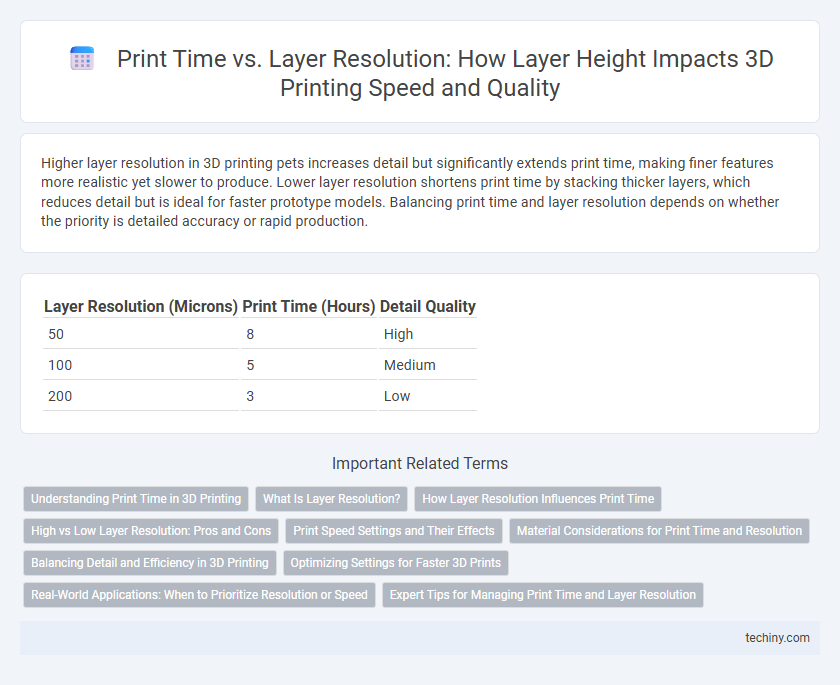Higher layer resolution in 3D printing pets increases detail but significantly extends print time, making finer features more realistic yet slower to produce. Lower layer resolution shortens print time by stacking thicker layers, which reduces detail but is ideal for faster prototype models. Balancing print time and layer resolution depends on whether the priority is detailed accuracy or rapid production.
Table of Comparison
| Layer Resolution (Microns) | Print Time (Hours) | Detail Quality |
|---|---|---|
| 50 | 8 | High |
| 100 | 5 | Medium |
| 200 | 3 | Low |
Understanding Print Time in 3D Printing
Print time in 3D printing is directly influenced by layer resolution, with higher resolution requiring thinner layers and consequently longer printing durations. Optimizing print speed involves balancing layer height against desired surface detail, as finer layers improve print quality but increase build time exponentially. Efficient print time management depends on selecting appropriate layer resolution settings tailored to the model's complexity and functional requirements.
What Is Layer Resolution?
Layer resolution in 3D printing refers to the thickness of each individual layer deposited during the printing process, typically measured in microns (um). Higher resolution means thinner layers, resulting in finer detail and smoother surface finishes but significantly increasing print time due to the greater number of layers required. Optimizing layer resolution balances the desired print quality with acceptable production speed, making it a critical factor in manufacturing and prototyping accuracy.
How Layer Resolution Influences Print Time
Layer resolution directly impacts print time, as higher resolution with thinner layers requires more layers to complete the object, significantly extending the printing duration. Conversely, lower resolution with thicker layers reduces the number of layers, speeding up the print process but potentially sacrificing surface detail and accuracy. Optimizing layer resolution balances desired print quality and efficiency, critical for time-sensitive 3D printing projects.
High vs Low Layer Resolution: Pros and Cons
High layer resolution in 3D printing produces finer details and smoother surface finishes, enhancing the quality of intricate models but significantly increases print time due to more layers required. Low layer resolution speeds up the printing process and reduces material usage, making it ideal for rapid prototyping and larger objects, but sacrifices detail and surface smoothness. Choosing between high and low resolution depends on the project's priority, whether it is precision or efficiency.
Print Speed Settings and Their Effects
Print speed settings directly influence print time and layer resolution, where faster speeds reduce print time but may compromise surface detail and precision. Higher layer resolution requires slower print speeds to achieve finer details, increasing the total print time significantly. Balancing print speed and layer resolution is essential for optimizing quality while maintaining efficient production timelines in 3D printing.
Material Considerations for Print Time and Resolution
Material properties such as viscosity, curing time, and thermal conductivity significantly influence print time and layer resolution in 3D printing. High-viscosity resins or filaments traditionally require longer curing or cooling phases, thus extending print durations while finer layer resolutions demand more precise material flow control. Selecting materials compatible with optimal printing speeds and resolution thresholds enhances overall print efficiency and quality.
Balancing Detail and Efficiency in 3D Printing
Print time in 3D printing is directly affected by layer resolution, with higher resolutions producing finer details at the cost of longer print durations. Selecting an optimal layer height balances intricate surface quality and efficient production speed, crucial for prototyping and functional parts. Advances in printer technology and slicing software enable fine-tuning this trade-off to meet specific project requirements without compromising quality or efficiency.
Optimizing Settings for Faster 3D Prints
Reducing layer resolution directly decreases print time by increasing layer thickness, enabling printers to lay down fewer layers for the same object height. Optimizing settings such as layer height, print speed, and infill density balances surface quality and speed, significantly accelerating print completion without sacrificing structural integrity. Selecting an ideal layer resolution based on prototype requirements ensures efficient use of material and machine time, improving overall productivity in 3D printing workflows.
Real-World Applications: When to Prioritize Resolution or Speed
In 3D printing, balancing print time and layer resolution is crucial depending on application requirements. High-resolution layers deliver intricate details essential for prototypes and custom medical implants, though they increase print duration significantly. For functional parts or large-scale models, prioritizing print speed using lower resolution minimizes production time while maintaining adequate quality for practical use.
Expert Tips for Managing Print Time and Layer Resolution
Optimizing layer resolution directly impacts print time, with finer layers significantly increasing duration while enhancing detail quality in 3D printing. Experts recommend balancing layer height based on project requirements, using coarser layers for prototypes to reduce print time without compromising structural integrity. Employing adaptive layer height techniques allows dynamic adjustment of resolution during printing, maximizing efficiency and achieving optimal surface finish where needed.
Print Time vs Layer Resolution Infographic

 techiny.com
techiny.com